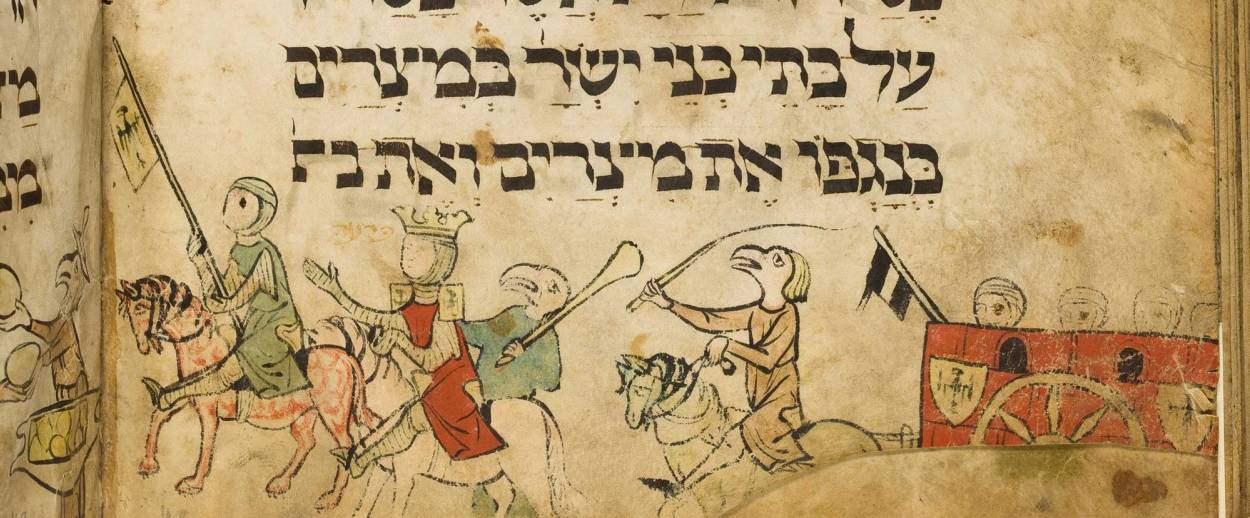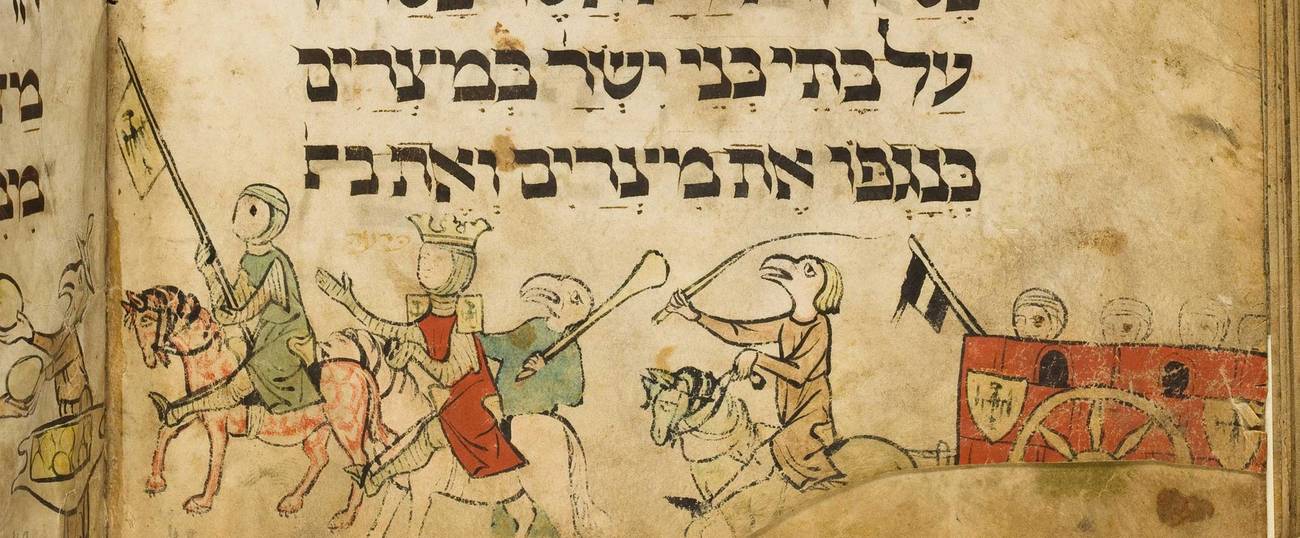Illuminating the Book of Esther
Creating a new kind of Megillah—using the historic Birds’ Head Haggadah as inspiration




For decades, scholars have written pages and pages attempting to solve the enigma of the so-called “Birds’ Head Haggadah,” an illustrated manuscript of the Passover Haggadah probably created in Germany in the early 14th century. Scholars have described the work as the earliest-known illuminated version of a Haggadah; its remaining 47 folios are preserved in the Israel Museum in Jerusalem. The mystery so many academics have been fascinated by lies in the way the characters are depicted around the text—with human bodies and sharp-beaked, bird-like heads.
A professor of Jewish studies at Vassar College, Marc Michael Epstein has introduced a series of provocative theories to the long-running academic conversation about this Haggadah. Now, after questioning the existing theories, claiming that those illustrated creatures are in fact griffins, and even challenging the academic community to rename the manuscript, he’s taking his research one step further. He’s creating a new illuminated manuscript, in the style of the Haggadah—but this time, it’ll be a Megillah.
Supported by Vassar, Epstein has involved a number of experts and professionals, including scribe Jen Taylor Friedman and illuminator Barbara Wolff. The text of the Book of Esther will be completed on parchment this summer; then, Epstein will gather some of his students in an intensive course, in which they will analyze the illustrations of the old Haggadah and create the new Megillah, which he expects to be completed by Purim of next year.
The idea behind the project is that the creation of the new manuscript will invite the students to dive into the medieval manuscript, analyzing its style, composition, and iconography in depth.
“As a pedagogical project, it’s very clever,” said Friedman, who is writing the script of the Megillah in the same style of the Griffins’—or Birds’ Head—Haggadah. Friedman, who is based in Montreal, where she is pursuing a doctorate degree, is the first woman to ever complete a Torah scroll. (She is also the creator of Tefillin Barbie.) “I think that to create something in its style, you need to understand the style very well,” Friedman continued. “Using the skill takes a deeper understanding.”
Ever since he was a child, Epstein has been fascinated with Jewish manuscripts, Haggadot in particular. He remembers sitting next to his father, an artist, and looking at a facsimile of the Venice Haggadah, a famous and beloved book from 1609. Today, Epstein studies “the art made for and by Jews,” he told Tablet. “I don’t call it Jewish art, because in many cases it was made by non-Jews for Jews.”
“When I first encountered the Birds’ Head Haggadah, I realized I’d run into a problem,” he said. “If we assume that a manuscript reflects like a mirror the life of the people who created it, when we study a manuscript like this Haggadah … we have a problem. People obviously don’t have the heads of birds.”
In his 2011 book The Medieval Haggadah: Art, Narrative, and Religious Imagination, Epstein summarized the different streams of interpretation centered around the bird-headed creatures depicted in this Haggadah, which are either enacting the narratives of the Exodus—as told in the written text—or engaged in the observance of the holiday of Passover. Before Epstein, some scholars suggested the figures were animal-like so that they wouldn’t violate the halachic restrictions on the depiction of human faces; others thought they mirrored the “stereotypical anti-Jewish depictions of Jews in Christian art.”
“It doesn’t quite make sense, that in a manuscript made for Jews—which is a very expensive commodity—Jews would have horrific Jewish caricatures illustrated, and pay for it, and preserve it,” said Epstein.
In fact, Epstein suggested that the creatures were not birds, but griffins, “lion-eagle hybrids present in biblical iconography in the Tabernacle and in Solomon’s Temple.” He also noticed that while the griffins represented the Jewish characters in the narration, other figures, blank-face, represented the gentiles.
Rather than performing as a mirror, he concluded, the manuscript performed as a projector: “It projects the wishes, the hopes, and the dreams of the people who commissioned it,” said Epstein, who has renamed it the “Griffins’ Head Haggadah,” although the Israel Museum does not intend to change its name.
After seeing a children’s “pop up” edition of the Haggadah inspired by the original manuscript published by Koren, Epstein was “charmed and appalled.” So he decided to create his own version.
As an expert of medieval manuscripts, he thought to transfer the concept of the Griffins’ Head Haggadah to the Book of Esther. (“I’m a little bored of Haggadot,” he said.) The two works are indeed set in two different eras and in different parts of the world, but both tell a story about the Jewish people and the “outside” world, the gentiles; in the first it’s the Egyptians, in the second it’s the Persians.
But one major difference between the Haggadah and the Book of Esther allowed the professor to revise the role of those “blank-face” characters, which presumably represented the gentiles in the manuscript: While in the former text, there is “less ambiguity,” as “Egyptians are all evil,” in the latter, figures like Vashti and Ahasuerus are more ambiguous.
“In the Haggadah, [the blank face] is a symbol of erasure. In the Megillah, it will be a symbol of ambiguity, a tabula rasa,” he said.
Epstein proposed the project to Vassar and found a few patrons to sponsor it, including a local egalitarian Jewish congregation, Kehillah Kedoshah Zikhron Zvi. The plan is to have the Megillah written on parchment by Friedman and then proceed with the illumination of the text in the fall with approximately 43 marginal images—one for each column. Together with his students, and with Wolff’s involvement, Epstein will select the subjects of the illuminations, which will be inspired by both the text and the Midrash.
“The students will read the Midrashim on the Megillah and we’ll select the images,” Epstein said, adding that, for example, there might be an illustration of the daughter of Haman committing suicide after realizing she’s thrown a jar full of excrement on her father by mistake.
Friedman, the scribe, has to imitate the same calligraphy of the original Haggadah. She described it as a Gothic, Hebrew script common in other works from the region of Mainz around the 14th century. “I had to sit down with a printout of the Griffins’ Head Haggadah and try to copy it. It was my first time,” she said. “I worked on it for a while.”
The project, she said, is a “fun combination” for her. As a scribe, she writes sacred texts; as a researcher, she studies medieval manuscripts. Now, she gets to do “both at once.”
“It’s making me sorry that I live in Canada,” she added. “I’d like to take this course. It sounds really cool.”
Simone Somekh is a New York-based author and journalist. He’s lived and worked in Italy, Israel, and the United States.